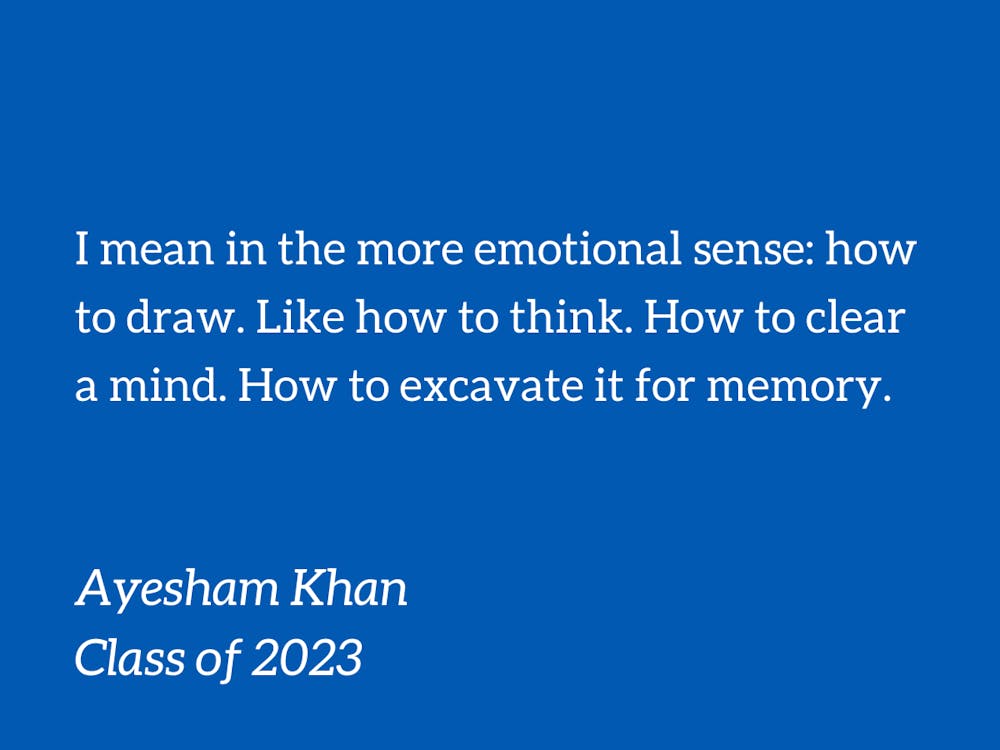Lately, I have been looking into how a line is born.
It was a rainy Saturday when I learned how to draw. I turned my lava lamp on, the overhead light off and sprawled out on my bed next to a vial of fruit flies and a photo of a microscopic image I took of one of them. Most of my nights are spent in such a way, fevered and meditative, attempting to piece together all the bits of scattered advice my drawing instructor had given me in his studio in Lahore. He taught me how to hold my graphite pencil authoritatively. On day one, I was meek with it. I held it with my thumb on the left and four fingers on the right, as if I was ready to pen a letter. By the end of the month, it sat in my fist as if it were a magic wand, and my arm told it where to go.
This fall, I’m trying to recollect everything he taught me. Most of my days are spent in the sculpture and puppetry studios near Swift, both within orbit of each other. While I am an avid museumgoer, I have never been in the studio. I have looked at countless pieces of art and felt agitated at my inability to pick out the process that created it. In museums, there is a veil between the art and the viewer that is never completely lifted. The artwork rests on the wall, coquettish, never giving up the secrets that led to its birth. In the sculpture studio, there is no shyness. Artwork is stripped naked of its readiness. There are unfinished pieces everywhere, not yet sanded down or polished, some yet to be carved, some unclimaxed yet, the paper clay still wet and crumbled like a patch of mud waiting to be stepped on.
I recall my instructor telling me to trust the process, to let a line out like vomit and allow it to empty me. His words ring clear and true here, where being unfinished is a constant state of being, and where making is thinking without pretense. Here, I am not surveilling. I am behind the scenes: in the dressing room, the girls’ bathroom and the pregame.
For class here, I bring a picture of a fruit fly so that I can sculpt it. To prepare, I sketch this little insect out countless times, each time peeling apart a new layer of its sinew. I prepare by committing myself to this one image. Sometimes I feel stuck. There is too much clutter in my mind, clouding my ability to let the graphite breathe.
“How To Draw,” I google. I don’t mean to learn how to draw like how to take a pencil and drag it across paper. I mean in the more emotional sense: how to draw. Like how to think. How to clear a mind. How to excavate it for memory. How to satiate hunger. How to take my jacket off, flex my fingers and let them twitch until they come to a rest. How to be a better friend, how to let my mother know I love her so I don’t have to think about it at my work desk. How to be quiet. How to empty my mind completely so that I can let myself imagine where my hand wants to plant itself next.
I practice relentlessly until I make myself miserable. The lines are unstable at first, and within a few days, I get more belligerent. I relish the intimacy of it all. Where before, I felt myself struggling to grasp a picture to marry myself to in the vein of the artists I admire so much, I now feel rooted. I have intimately known fruit flies, from vintage diagrams to 3D renderings and anatomically correct likenesses. I am learning slowness, patience and attentiveness.
In trying to be a better artist, I am trying to become a better observer and a better friend. The pages of my sketchbook are heavier, rougher. The insides of my eyelids can picture every line, the trace of the iridescent wing stretching to meet the browned exoskeleton and the yellowy underbelly. This is the closeness of the line, how it lets you navigate the bodies you aim to perfect in your work, like a cartographer. How to draw is how to play, how to be slow. How to be.
Ayesham Khan is a Trinity senior. Their column "microscopy" typically runs on alternating Tuesdays.
Get The Chronicle straight to your inbox
Signup for our weekly newsletter. Cancel at any time.

